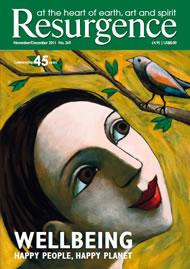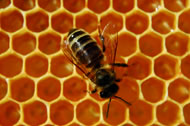There is a barely perceptible air of performance about Luke Dixon. He is perhaps in his early fifties – though he’s got that healthy, well-heeled sort of glow that makes it difficult to tell. We’re introduced by a friend who used to know him as a theatre director. Luke still does theatre in the winter, but in the summer he now keeps bees. He’s warm and unassuming, and he wears his beekeeperness with a playfulness I didn’t spot at first. Pink socks peep out under trouser legs, a cream linen suit and pink shirt soft in the early spring sunlight when we meet for the first time at Coram’s Fields, just off Russell Square in London. He could be an English gentleman, but he’s carrying a pink laptop, and plastic bags filled with strange metal contraptions, heavy gloves and boots and full-body suits. There’s just a hint of dishevelment about him, and I imagine that elsewhere he might be anyone – that he could easily take on umpteen other roles. The only time he lets any of himself slip is when I ask him why he became a beekeeper, and he replies that the theatre world is full (not ‘too’, just ‘full’) of people and egos. He says the only similarity between theatre people and bees is that both spend long periods of time in darkened rooms, and that for him there is something meditative about beekeeping (does he also say that it opens him up to being out of doors?). None of these remarks quite seems to relate to the next, but I like how he tells it without any beef or baggage or worn-down cynicism.
And it had struck me that day that there is something meditative about beekeeping. Because from the moment you lift the lid and announce yourself to the bees’ world below, you must remain aware of every moment. Utterly attentive and alert to what’s moving and staying still and changing around you. Maybe as you become familiar with this you slip into something like autopilot. Maybe. Luke intervenes as little as possible, but where he does raise the roof – transferring one hive into another – the bees rise up in a cloud around us, and now I am only a gauze-breath away. Standing in the midst of a swelling mass of unsettled and pollen-heavy bees, wondering how I had failed to anticipate that it would also feel terrifying to be up this close. Meanwhile Luke is moving quickly and steadily, checking the condition of the hive’s interior and keeping an eye out for disease as he goes.
There is growing interest in natural beekeeping as an alternative to modern practices. Natural beekeepers emphasise the need for a non-interventionist approach, leaving bees for the most part to build and maintain the interiors of the hives themselves. Whereas in modern hives square boxes containing honeycomb frames are built up in layers from a brood box at the bottom, in the wild bees build downwards in lobes from a fixed point above. There are clear evolutionary advantages to this, since as the bees build down, the queen lays her eggs in the lower layers, so any disease is left further up the comb. Natural beekeepers allow bees to follow this pattern, so although their lack of interference means they check less for disease, there is also less disease present than in modern hives. I wonder how often, tasking ourselves with the management of another being or system, our own methods of care-keeping actually perpetuate those diseases we imagine we are trying to prevent…
There does seem something intuitive about allowing creatures to build in the direction they lean naturally towards. Yet even in modern hives bees continue to build according to their own logic and patterns. Luke removes a frame from the brood box to point out the concentric circles forming within the straight-lined frame. The honeycomb is divided into an inner core where eggs are laid, circled by a layer of larvae, another of pollen to feed the young, and a final outer layer of nectar being made into honey. Where we lift the lid we find honeycomb crusts forming in empty gaps, rising out in soft waves from the gridlines either side.
I am captivated by the bees’ interior world, but their life in the open air is no less remarkable, their capacity for connection extending beyond their own species into mutually beneficial relationships with the world around them. (I wish I were a bee.) It is difficult to get my head around the repercussions of that momentary touch between bee and plant. The gentle probings of the honeybee who, drunk on scent, rubs dustily up against the inside of a flower to trigger a process of fertilisation vital to the functioning of our planetary ecosystem as a whole. One-third of all our food staples are pollinated by these tiny creatures who, in their ordinariness, buzz about our picnic rugs and fuzz incessantly at our windowpanes. Yet their numbers are deteriorating. Increased monocropping, overuse of pesticides, changing climates and the spread of disease have all been linked to a worrying decline now global in scale.
Luke’s beekeeping has attracted attention in London, where he has over 30 hives in different locations across the city, from businesses to housing estates. Most are perched high on rooftops, commissioned by companies who – eager to tick their ‘green’ boxes – are lining up or falling over themselves to install wild-flower gardens, beehives and even, at one particularly competitive organisation, an urban goat.
So, for the most part, we who bustle through this city remain unaware – as we cross the street, close the door, open a window – of that bee world existing above and between us or just out of reach, though we buy up the honey faster than it comes, and now and then find ourselves stung, or disrupted by that sound at the windowpane.
Yet on occasion bees appear in the city in more conspicuous ways. When a colony decides to reproduce itself it divides into two, one half collecting into a swarm to search for a new hive. Luke has photos taken last year of swarms in unseemly places. They’re strange and disturbing, like something out of a sci-fi film: hundreds of them stilled, masquerading as a lamp post in the centre of Soho or a tree branch on a housing estate in South London. I learn that there is such a thing as a swarm collector: this is the person to call in London when bees forget their place and settle too close, unsettling us city people.
Over the next few weeks I’m back for more, following Luke past gatekeepers at reception desks, along corridors and up stairways, clambering through windows and onto roofs. One afternoon we meet in the midst of the rush hour to visit two hives installed six storeys up. The bees are entering their active season, but this afternoon they seem slow. We’re done quickly, and while Luke is putting the suits away I tiptoe-lean at the wall to peer over the edge. Up on the rooftops things shift position, and from this perspective it is we humans who swarm, antlike, along Oxford Street below. I turn, steadying myself. We take off our bee-suits and our gauze masks and return to the dim light and mirrored walls of the lift, back to the rush-hour bodies bustling busily (buzzily) about.








